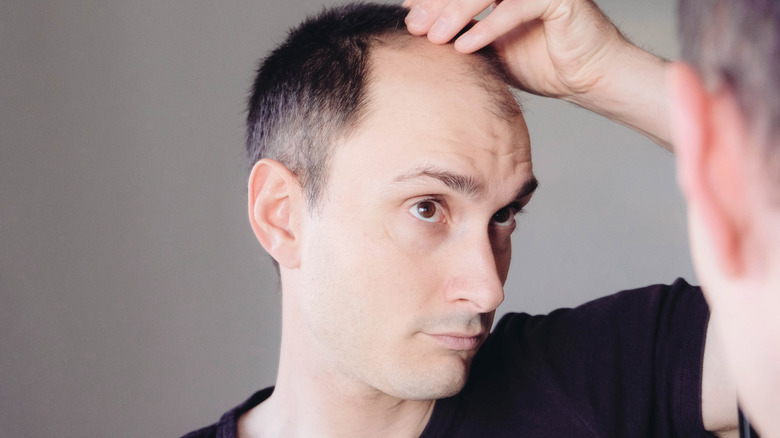Is There A Genetic Link To Male Pattern Baldness?
Male pattern baldness, also known as androgenetic alopecia, is the most common type of hair loss, affecting up to 50% of people, according to a 2022 article published in the journal StatPearls. The condition usually causes a gradual loss of hair from the scalp, which typically starts with a receding hairline, followed by thinning of the hair on the crown of the head. Eventually, the hair loss leads to a U-shaped ring of hair around the back and sides of the head.
The causes of male pattern baldness are complex and are believed to be caused by a combination of factors. While the condition is a natural and common part of aging for many men, it can significantly impact self-esteem and body image. Fortunately, several treatment options are available for men concerned about hair loss. However, understanding the main causes of male pattern baldness is vital before considering treatment options.
Do genetics play a role in male pattern baldness?
Both genetics and hormones may play a role in the development of male pattern baldness. The hormone dihydrotestosterone (DHT) is connected with the condition, via Healthline. DHT is produced from testosterone by the enzyme 5-alpha-reductase, and it binds to receptors in hair follicles — over time, DHT can cause the hair follicles to shrink, leading to thinner and shorter hair that falls out and takes longer to grow back, if it ever does.
Research has shown that male pattern baldness is largely inherited from one's parents. In fact, genetics accounts for up to 80% of the risk of developing the condition, per a 2017 study published in the journal PLOS Genetics. According to the study, several genes have been associated with male pattern baldness. The most well-known is the androgen receptor gene, a protein that DHT binds to. Variations in this gene can lead to an imbalance in the binding process within the hair follicles, which can lead to male pattern baldness.
Treatment for male pattern baldness
While there is no cure for male pattern baldness, several treatments can help slow down or even reverse its progression. One of the most common treatments for hair loss caused by male pattern baldness is medication. According to Penn Medicine, minoxidil (brand name Rogaine) is a commonly prescribed medication that promotes hair growth by increasing blood flow to the hair follicles. Another medication, finasteride (brand name Propecia), interrupts the production of the testosterone that causes baldness. Both of these medications are available in both prescription and over-the-counter forms.
Hair transplant surgery is another treatment option for male pattern baldness. This involves taking hair follicles from one part of the scalp and transplanting them to the bald or thinning areas, per Healthline. Several techniques are available for hair transplant surgery, including follicular unit transplantation (FUT) and follicular unit extraction (FUE).
Platelet-rich plasma (PRP) therapy is another treatment for male pattern baldness. It involves injecting a concentration of platelets into the scalp, via Penn Medicine. Hairpieces and wigs can be a good option for men not interested in medication or surgery. These can be custom-made to match hair color and style and provide a natural-looking solution for hair loss.



